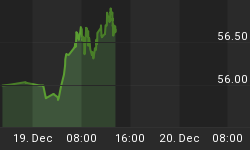Of all the problems with fiat currency, the most basic is that it empowers the dark side of human nature. We're potentially good but infinitely corruptible, and giving an unlimited monetary printing press to a government or group of banks is guaranteed to produce a dystopia of ever-greater debt and more centralized control, until the only remaining choice is between deflationary collapse or runaway inflation. The people in charge at that point are in a box with no painless exit.
Prudent Bear's Doug Noland describes the shape of today's box in his latest Credit Bubble Bulletin:
Right here we can identify a key systemic weak link: Market pricing and bullish perceptions have diverged profoundly both from underlying risk (i.e. Credit, liquidity, market pricing, policymaking, etc.) and diminishing Real Economy prospects. And now, with a full-fledged securities market mania inflating the Financial Sphere, it has become impossible for central banks to narrow the gap between the financial Bubbles and (disinflationary) real economies. More stimulus measures only feed the Bubble and prolong parabolic ("Terminal Phase") increases in systemic risk. In short, central bankers these days are trapped in policies that primarily inflate risk. The old reflation game no longer works.
In other words, most real economies (jobs, production of physical goods, government budgets) around the world are back in (or have never left) recession, for which the traditional response is monetary and fiscal stimulus -- that is, lower interest rates and bigger government deficits. Meanwhile, the financial markets are roaring, which normally calls for tighter money and reduced deficits to keep the bubbles from becoming destabilizing.
Both problems are emerging simultaneously and the traditional response to one will make the other much, much worse. Some more specifics from Noland:
Let's begin with a brief update on the worsening travails at the Periphery. The Russian ruble sank another 6.5% this week, increasing y-t-d losses to 37.9%. Russian (ruble) 10-year yields jumped another 146 bps this week to 12.07%...
Increasingly, emerging market contagion is enveloping Latin America. The Mexican peso was hit for 1.6% Friday, boosting this EM darling's loss for the week to a notable 3.0%. This week saw the Colombian peso hit for 4.3%, the Peruvian new sol 1.1%, the Brazilian real 0.9% and the Chilean peso 0.6%. Venezuela CDS (Credit default swaps) surged 425 bps to a record 2,717 bps. Brazilian stocks were slammed for 5% this week and Mexican equities fell 2.2%...
Declining 1.3%, the Goldman Sachs Commodities Index fell to the low since June 2010. Crude traded to a new five-year low. Sugar fell to a five-year low, with coffee, hogs and cattle prices all hit this week.
And a quick look at the bubbling Core: The Dow 18,000 party hats were ready, although they will have to wait until next week. The S&P500 traded Friday to another all-time record. Semiconductor (SOX) and Biotech (BTK) year-to-date gains increased to 31.4% and 48.1%, respectively. The week also saw $4.0 Trillion of year-to-date global corporate debt issuance, an all-time record. Italian (1.98%), Spanish (1.83%) and Portuguese (2.75%) yields traded to all-time record lows again this week.
What differentiates today's reflation from those that "worked" in the past? The current reflation has overwhelmingly manifested within the Financial Sphere. And that's the essence of why I believe the Bubble is now running on borrowed time. It's a critical issue that goes completely unrecognized these days: In the end, Financial Sphere inflations are unsustainable.... The entire world believes central bankers will support stock, bond and asset prices. Everyone believes central bankers will ensure liquid markets. Most believe global policymakers will forestall financial and economic crisis for years to come. And it is these beliefs that account for record securities prices in the face of a disconcerting world.
We are, in short, down to the final myth that animates the blow-off phase of most bubbles: that of the omnipotent government/central bank which likes the status quo and has the power to maintain it. They don't have that power, of course, or else financial bubbles would never burst and we'd still be living in the golden age of junk bonds, dot-coms and subprime mortgages.
What's different about this iteration is that instead of being confined to a single asset class, the bubble is in financial assets generally, including fiat currencies, government debt, corporate bonds and equities, along with all their related derivatives. Where previous bubbles accounted for hundreds of billions or at most one or two trillion dollars, this one is denominated in hundreds of trillions spread from emerging market bonds to money center bank interest rate derivatives. The number of moving parts and the magnitude of the hidden risks guarantee that when it comes, the dissolution of today's myth structure will be like nothing any of us have ever seen.















